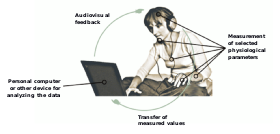
Biofeedback

Biofeedback is the process of gaining greater awareness of many physiological functions primarily using instruments that provide information on the activity of those same systems, with a goal of being able to manipulate them at will. Some of the processes that can be controlled include brainwaves, muscle tone, skin conductance, heart rate and pain perception. In biofeedback, you are connected to electrical sensors that help you receive information (feedback) about your body (bio). Biofeedback is the process of gaining greater awareness of many physiological functions primarily using instruments that provide information on the activity of those same systems, with a goal of being able to manipulate them at will. Some of the processes that can be controlled include brainwaves, muscle tone, skin conductance, heart rate and pain perception. In biofeedback, you are connected to electrical sensors that help you receive information (feedback) about your body (bio). Biofeedback may be used to improve health, performance, and the physiological changes that often occur in conjunction with changes to thoughts, emotions, and behavior. Eventually, these changes may be maintained without the use of extra equipment, for no equipment is necessarily required to practice biofeedback. Biofeedback has been found to be effective for the treatment of headaches and migraines. Information coded biofeedback is an evolving form and methodology in the field of biofeedback. Its uses may be applied in the areas of health, wellness and awareness. Biofeedback has its modern conventional roots in the early 1970s. Over the years, biofeedback as a discipline and a technology has continued to mature and express new versions of the method with novel interpretations in areas utilizing the electromyograph, electrodermograph, electroencephalograph and electrocardiogram among others.The concept of biofeedback is based on the fact that a wide variety of ongoing intrinsic natural functions of the organism occur at a level of awareness generally called the 'unconscious'. The biofeedback process is designed to interface with select aspects of these 'unconscious' processes. The definition reads:Biofeedback is a process that enables an individual to learn how to change physiological activity for the purposes of improving health and performance. Precise instruments measure physiological activity such as brainwaves, heart function, breathing, muscle activity, and skin temperature. These instruments rapidly and accurately feed back information to the user. The presentation of this information—often in conjunction with changes in thinking, emotions, and behavior—supports desired physiological changes. Over time, these changes can endure without continued use of an instrument. A more simple definition could be:Biofeedback is the process of gaining greater awareness of many physiological functions primarily using instruments that provide information on the activity of those same systems, with a goal of being able to manipulate them at will. (Emphasis added by author.) In both of these definitions, a cardinal feature of the concept is the association of the 'will' with the result of a new cognitive 'learning' skill. Some examine this concept and do not necessarily ascribe it simply to a willful acquisition of a new learned skill but also extend the dynamics into the realms of a behavioristic conditioning (7). Behaviorism contends that it is possible to change the actions and functions of an organism by exposing it to a number of conditions or influences. Key to the concept is not only that the functions are unconscious but that conditioning processes themselves may be unconscious to the organism. Information coded biofeedback relies primarily on the behavior conditioning aspect of biofeedback in promoting significant changes in the functioning of the organism. The principle of 'information' is both complex and, in part, controversial. The term itself is derived from the Latin verb informare which means literally 'to bring into form or shape'. The meaning of 'information' is largely affected by the context of usage. Probably the simplest and perhaps most insightful definition of 'information' was given by Gregory Bateson—'Information is news of change' or another as 'the difference that makes a difference'. Information may also be thought of as 'any type of pattern that influences the formation or transformation of other patterns'. Recognizing the inherent complexity of an organism, information coded biofeedback applies algorithmic calculations in a stochastic approach to identify significant probabilities in a limited set of possibilities.
